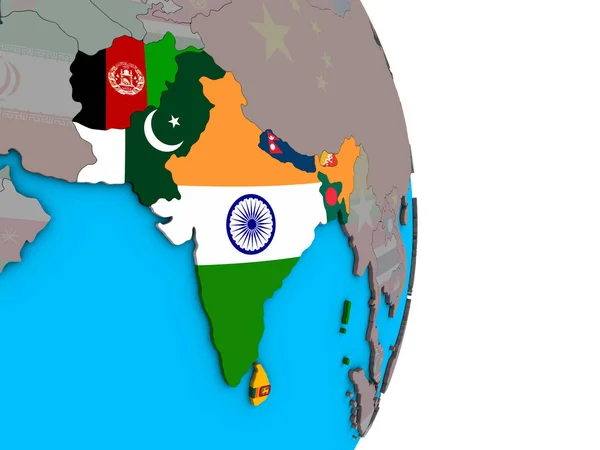Does India Suck at Neighborhood Diplomacy?
Does India Suck at Neighborhood Diplomacy?
ET2

“You can change friends, but you cannot change neighbors.”
— Atal Bihari Vajpayee, Former Prime Minister of India
It's not a great time for Indian diplomacy. Maybe they are doing a decent job in Western countries, but the same cannot be said for its relations with neighboring nations. A country having direct land borders with six countries and maritime proximity with two others can be expected to have some regional allies. Sadly, that’s not the case. Most of them openly consider India less a benevolent partner and more a threat to their sovereignty, while others are maintaining only superficial relations with it. So, what has gone wrong that former allies have turned into formidable opponents?
When the BJP came to power in 2014, it prioritized the theme of “Neighborhood First Policy,” making efforts to reactivate SAARC, uphold bilateral relations, and pledge not to meddle in neighbors’ domestic affairs. But that didn’t continue for long, as gradually its neighbors began to turn their backs on the most powerful nation of South Asia. Indian media, fragile duplicity led diplomacy, all contributed to this issue. Whether through economic leverage, strategic infrastructure, or subtle, subterranean displays of military presence, India has often appeared more hegemonic than harmonious toward its neighbors. We can start with Bangladesh, the friendliest country to India for more than a decade, where, after August 5th, 2024, relations changed significantly. Anti-India sentiment peaked at an all-time high due to India’s dominance over Bangladesh in the previous regime, which was ousted by a student-led movement last year. Bangladeshis believe that from river water sharing to indiscriminate killings along the India-Bangladesh border, India behaved unfairly. The trade deficit between these two countries stands at a staggering $8.6 billion, underscoring the paucity of exports flowing into India from its neighbor. By granting shelter to former Prime Minister Sheikh Hasina, India cemented the perception that it interferes in Bangladesh's internal affairs. This singular act continues to reverberate in the country’s political discourse.
Sri Lanka, currently led by a pro-China administration, relies more on China than on India. The relationship between Sri Lanka and India has faced many vicissitudes. Allegedly supporting Tamil Tiger rebel groups, deploying troops in their territory, and deprecating Lankan fishermen by restricting access to their own maritime zones all led to internal disputes between the nations. Though Sri Lanka is receiving loans from India, that hasn’t been enough to change the political landscape as a whole. Relying on China, in such close proximity to India, poses a serious strategic threat. The dominating posture assumed by Indian diplomacy deeply upset the Lankans, resulting in a complicated relationship. “India Out” was the slogan of the party currently running the Maldives. Removing India’s military presence was the center of Mohamed Muizzu’s campaign. A huge backlash was seen in India too, from cutting relationships to cancelling trips to the Maldives by Indian tourists. Leaning toward China seemed inevitable at that time. This 2023 incident sent a clear message to the world: India’s dominance is being actively opposed by its neighbors, fueling anti-India sentiment across Bangladesh and Sri Lanka. Though Prime Minister Modi is now trying to mend the relationship by striking deals with the current Maldivian government, the damage has already been done.
Nepal, the only Hindu-majority country in the world, might be expected to be India’s closest ally, but reality paints a different picture. The previous monarchy in Nepal, backed by India, was overthrown by popular movement, symbolizing a bold defiance of Indian dominance. Tensions have simmered ever since, fueled by long-standing territorial disputes. The situation worsened when Nepal’s current government unveiled a revised map that claimed a stretch of land also claimed by India, further straining their already fragile relationship.
The relationship between India and Pakistan is historically belligerent. A recent near-war situation left both sides with casualties. India claims Pakistan backs local militias in Jammu and Kashmir, creating turbulence in the region. Meanwhile, Pakistan has often accused India of being a “water terrorist,” alleging that New Delhi deliberately restricts river flows that sustain nearly 80% of Pakistan’s agrarian economy as well as its industrial sector. With China being a key ally of Pakistan, the dynamic becomes even more complicated. These two nuclear-armed nations have become a persistent security threat to the entire subcontinent, with their implacable rivalry fueling instability across South Asia. In this case, a hostile relationship may seem understandable.
Now, the ultimate threat to India, China, has become its biggest rival both economically and militarily. In addition, China’s increasingly successful foreign policy has ensured that most of India’s neighbors are now leaning more toward Beijing than toward New Delhi. In ongoing border disputes, China appears to be a key player, and their rivalry is likely to continue, shaping the balance of power in the region.
India could have been more sensible in managing its relationships with its neighbors, but instead, it miscalculated and misjudged. By abandoning dominating attitudes, responding to real needs, building joint projects, and balancing trade deficits, India still has the chance to fix its diplomacy before it's too late. A balanced and constructive relationship between India and its neighbors is essential for the welfare of the subcontinent. Without it, persistent tensions will continue to impede progress and risk relegating the whole of South Asia to stagnation.